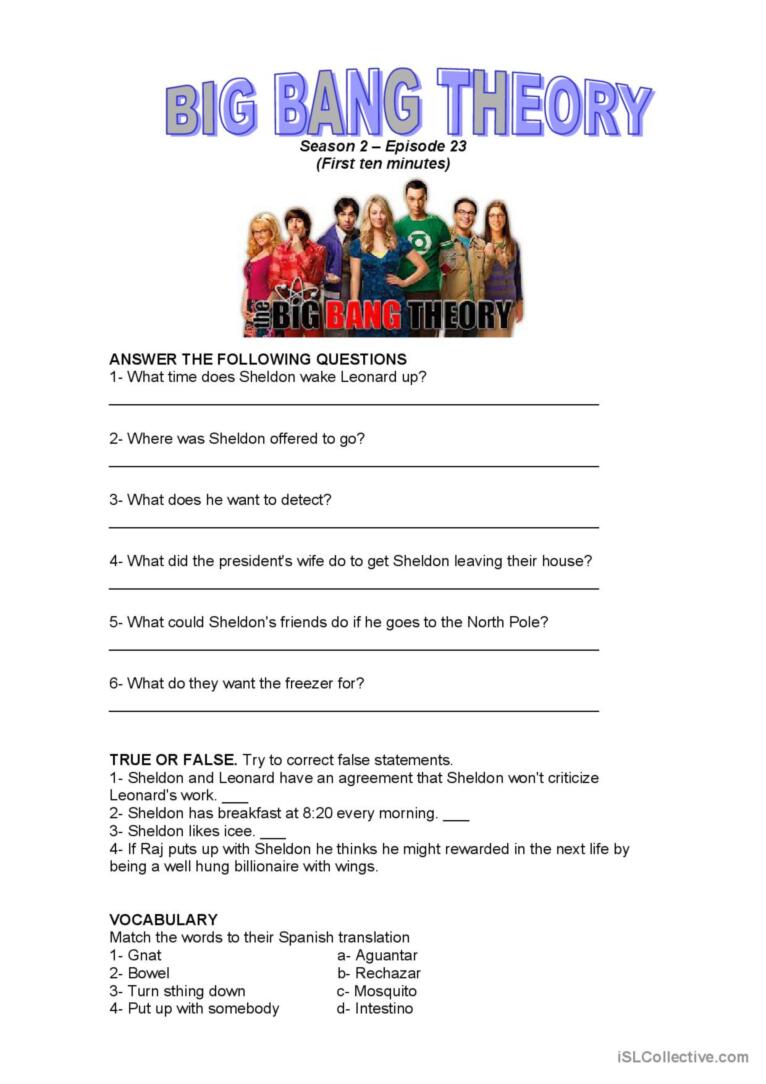Big Bang Theory Worksheet: Fun Science Learning Activity

The "Big Bang Theory" isn't just a popular television show; it's also the foundation of modern cosmology, explaining the origins of the universe. This scientific theory provides a framework for understanding how our universe came to be and has expanded over time. For students of all ages, this concept can be both awe-inspiring and educational. In this comprehensive worksheet, we'll dive into the Big Bang Theory through engaging activities and explanations that make learning about cosmology fun and accessible.
Understanding the Big Bang Theory

The Big Bang Theory suggests that the universe began as an infinitesimally small, dense point, which exploded over 13.8 billion years ago. From this singularity, the universe has been expanding and cooling, eventually leading to the formation of stars, galaxies, and eventually, life as we know it. Here’s what students can expect to learn:
- The sequence of events from the Big Bang to now.
- Key stages of the universe's evolution.
- How astronomers have developed evidence supporting this theory.
Activity 1: The Timeline of the Universe

To visualize the vast timeline of our universe, we can create an interactive timeline. Here's how:
- Start with a Long Paper Strip: Lay out a long paper strip representing the entire lifespan of the universe from the Big Bang to now.
- Mark Important Events:
- Planck Epoch
- Inflation
- Formation of the first subatomic particles
- Nucleosynthesis (formation of nuclei)
- Recombination (decoupling of matter and radiation)
- Formation of the first stars
- Galaxy formation
- Present Day
- Detail Each Era: Discuss what's significant about each stage, why it's important, and what came next.
- Spacecraft Simulation: Using simple models, illustrate how space expands, pushing galaxies apart.
🌟 Note: This activity is designed to give students a tangible sense of the vastness of cosmic time, which is crucial for understanding the Big Bang Theory's scale.
Activity 2: The Expanding Universe Simulation

To demonstrate how the universe expands, students can participate in a simple yet effective simulation:
- Materials: Balloons, sharpies, and string.
- Procedure:
- Inflate the balloon halfway.
- Draw dots representing galaxies on the balloon’s surface.
- Blow more air into the balloon and observe how the galaxies (dots) move apart.
| Stage of Inflation | Observation |
|---|---|
| First Stage | Dots are relatively close together |
| Second Stage | Dots spread further apart |
| Third Stage | Galaxies are distant from each other |

🌍 Note: While this is a simplified model, it helps visualize why galaxies are moving away from each other due to the expansion of space itself.
Activity 3: Evidence for the Big Bang

Learning about the evidence behind the Big Bang Theory is essential for students to grasp its validity. Here are some points to cover:
- Cosmic Microwave Background (CMB): The residual radiation from the Big Bang.
- Redshift: The shift of light to the red end of the spectrum, indicating that galaxies are moving away from us.
- Abundance of Light Elements: The ratio of hydrogen to helium in the universe supports nucleosynthesis predictions.
Discuss these evidence points in the classroom, using diagrams and videos to illustrate concepts like CMB radiation and redshift.
Connecting Modern Observations

Today's technology allows us to observe the universe as it was billions of years ago. Here are ways to bring modern science into the classroom:
- Hubble Space Telescope Images: Share images of galaxies and clusters to discuss how we observe past events.
- The Universe's Age Calculation: Explain how scientists determine the universe's age through different methods.
- Gravitational Waves: Introduce the concept of gravitational waves and how they support the Big Bang theory.
By integrating these observations into your lesson, students can connect theory with observable phenomena, enhancing their understanding of cosmology.
Wrapping Up the Journey

In this exploration of the Big Bang Theory, we've embarked on a journey from the smallest point in space-time to the vastness of our current universe. Through interactive activities, students have not only learned about the sequence of events following the Big Bang but have also engaged with the evidence supporting this monumental theory. The takeaway from this lesson is not just the scientific knowledge gained but also the inspiration to continue exploring the universe's mysteries, fostering a sense of curiosity and wonder about our cosmic origins.
What caused the Big Bang?

+
The exact cause of the Big Bang remains one of the great mysteries in cosmology. Current theories suggest it might be due to quantum fluctuations in a previous state of the universe or even a multiverse scenario where our universe is just one of many “bubbles.”
How can we see past the Big Bang?

+
We can’t see past the Big Bang because, in our understanding, time and space were created at that moment. What we observe are the echoes of the Big Bang, like the cosmic microwave background radiation.
What’s the significance of the CMB for the Big Bang theory?

+
The Cosmic Microwave Background (CMB) is a key piece of evidence for the Big Bang Theory. It’s the thermal radiation left over from when the universe was just 380,000 years old, providing a snapshot of the early universe’s conditions.
How does the expanding universe affect our understanding of gravity?

+
As the universe expands, galaxies move apart, weakening gravitational forces between them. This affects our understanding of gravity on cosmic scales, suggesting there might be other forces at play like dark energy.